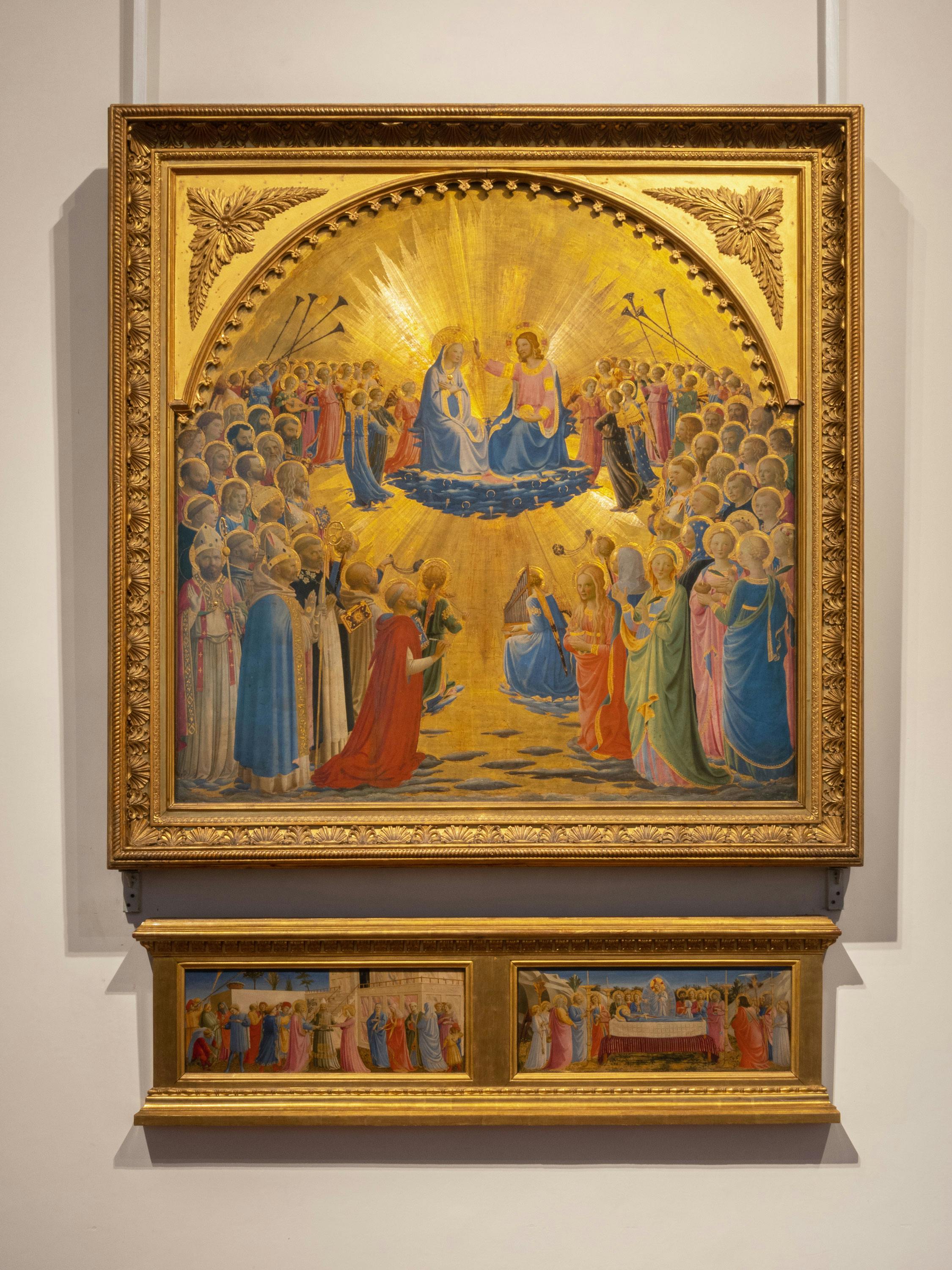Glorification of Mary (predella depicting the Marriage and Funeral of the Virgin)
Guido di Pietro, then Fra' Giovanni Angelico known as Beato Angelico (Vicchio di Mugello (Fi), ca.1395-Rome 1455)
The painting depicts the Virgin Mary assumed into Heaven, sitting enthroned next to Christ the Redeemer, amid jubilant angels dancing and playing instruments, and in the presence of hosts of saints. The Virgin is crowned queen, an iconography which, despite having no references in the Holy Scriptures, was very popular until the Middle Ages and associated with the triumph of the Church. However, the Uffizi painting shows a rather rare variant of the traditional depiction of the crowning of the Virgin: The Saviour does not place the crown on Mary's head, but is about to adorn the diadem with a precious stone. This detail probably translates into image a vision of the mystic Bridget of Sweden (1303-1373), who in a passage of her Revelations imagined Jesus Christ enriching Mary's crown with lilies and precious stones.
The dense hosts of saints consist of over forty figures of saints, each one different from the other and carefully characterized so that many can be identified. Among them, gathered in the foreground on the right, it’s possible to recognize Mary Magdalene, kneeling with her long hair down, and Lucy, who is dressed in blue and holding an oil lamp. On the other side, in the foreground, Saint Jerome is kneeling in cardinal's clothing, followed by Saint Dominic, who is wearing a black and white robe, and Bishop Giles, whose name is written in gold on his collar. The importance given to this saint is related to the destination of the painting: an altar in the partition of the hospital church of Santa Maria Nuova in Florence, dedicated to St. Giles. The panel was complemented by a predella consisting of two compartments depicting the Marriage and Death of the Virgin, which were separated from the painting above them in the second half of the 16th century, probably as a result of the renovation of the church. The compartments entered the Medici collections, in whose inventories they are mentioned as early as 1629; while the panel with the Glorification, which remained in Santa Maria Nuova, reached the Uffizi in 1825. Having lost the memory of the original union, it was exhibited individually. The panel and its predella split again after the Second World War: to protect it from the bombings and raids of the Nazi army, the altarpiece was sent away from Florence and concealed in various secret locations in the surroundings, including the Castle of Poppi and the Medici villa of Poggio a Caiano. Once the war was over, the work was divided into two parts: the panel, which returned to the Uffizi, and the predella, which was sent to the San Marco Museum where it has remained for decades until the reunification in Spring 2024.
Alongside Masaccio, Beato Angelico was a leading figure of Florentine painting in the early Renaissance; he was able to combine his artistic skills with profound religious sentiment, translating complex theological concepts into seraphic visions. In the Uffizi painting, the compact and uniform gold-ground, which was typical of medieval tradition, is moved by the engraved halo on which the light refracts, while the semi-circular arrangement of the figures and the slight decrease of their dimensions suggest a sense of depth.
S. Nocentini, in Beato Angelico, l’alba del Rinascimento, a cura di A. Zuccaro, G. Morello, G. de Simone, Milano 2009, pp. 178-179; G. de Simone in Bagliori dorati. Il Gotico internazionale a Firenze 1375-1440, a cura di A. Natali, E. Neri Lusanna, A. Tartuferi, Firenze 2012, p. 168; N. Silver in Fra Angelico. Heaven on Earth, a cura di N. Silver, Londra, 2018, pp. 180-193
